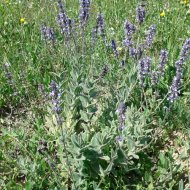Care of the plant Nepeta teydea or Canary Catmint |
|
The genus Nepeta, family Lamiaceae, comprises about 250 species of herbaceous plants native to Europe, Asia, and Africa. Some species and hybrids are: Nepeta teydea, Nepeta tuberosa, Nepeta cataria, Nepeta × faassenii, Nepeta grandiflora, Nepeta curviflora, Nepeta nepetella. Common name: Canary Catmint. This species is native to the Canary Islands. They are herbaceous perennial and aromatic plants that branch from the base and reach 1 meter (3.28 feet) in height when they flower. The oblong-lanceolate leaves have a velvety texture and a grayish-green color. The small blue, lilac or white tubular flowers appear on long erect spikes. They bloom in summer. Canary Catmint is used on dry and sunny slopes, in rockeries and borders and borders. It's ideal for Mediterranean coastal gardens. The leaves have anti-catarrhal, hypoglycemic and diuretic properties. Nepeta teydea needs full sun exposure and a warm, dry climate. It does not resist frost. Canary Catmint grows in any type of soil that has good drainage, be it stony, sandy or rocky. Always water moderately, waiting for the substrate to dry completely. Canary Catmint has good resistance to drought. Nepeta teydea does not need fertilizer. Prune wilted inflorescences after the flowering period. Canary Catmint is a plant resistant to the usual pests and diseases but sensitive to excess watering. Nepeta teydea is propagated from seeds sown in spring and by cuttings in summer or fall. |
Images of the plant Nepeta teydea or Canary Catmint |
Find plants
Nepeta teydea or Canary Catmint | Care and Growing
© 2026 FavThemes


